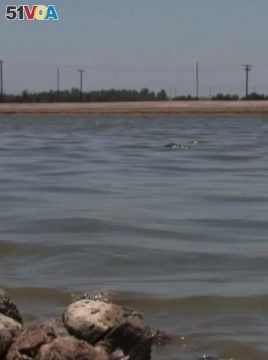June 24,2014
IMPERIAL, CALIFORNIA — As the world population grows, there is a growing need for more food - including seafood. By 2030, the World Bank expects that 70 percent of the demand for fish will come from Asia. A recent report led by the World Resources Institute finds that global fish production needs to more than double by the middle of the century to meet that demand. The WRI study says the world’s oceans, lakes and rivers are fished to their limit, and it encourages "sustainable growth" of aquaculture or fish farms.

In an ancient lake bed 26 kilometers north of the California-Mexico border, there is fresh water and new life.
“We’re probably the largest catfish farm this side of the Mississippi...the largest catfish farm in California,” said Craig Elliott, the co-owner of Imperial Catfish.
Elliott said that several times a week, thousands of kilograms of fish from his ponds end up in Asian grocery stores where live fish is in high demand.
“In fact, we can’t really produce enough fish for the demand,” he said.
As demand for seafood increases worldwide, so do the number of fish farms.
“It’s a relatively young industry but it grows at about 9 percent a year and we expect to keep that growth rate going in the next couple of decades,” said Mike Velings, founder of Aqua-Spark, a company that invests in sustainable aquaculture businesses.
Velings said China is the world leader in producing farmed fish. There are very few farms in the United States.
“The U.S. relies heavily on wild caught and on imports and only one percent of the world’s farming today is done in the U.S,” he added.
Elliott pointed out that aquaculture is not an easy business in which to make a profit.
“You put a fish in at this big and it’s going to be 18 months to two years before they are two to three pounds and so you have all that big outlay and you have no return for a long long time. Some people make it, some of them don’t,” said Elliott.
There are also environmental concerns. Activist Nathan Weaver cites the polluting impact of uneaten fish meal and waste products from farmed fish, in addition to the disruption of the natural food chain.
“Many of the species of fish we like to eat are large predatory fish, they are things like tuna or salmon that are already two or three levels up the food chain. So in order to farm these large carnivores you have to actually feed them smaller fish and the concern is that in order to keep a tuna farm or a salmon farm going you’ll end up having to catch all the little fish in the ocean,” said Weaver.
But the World Resources Institute says public policies, technology and private initiatives have prompted improvements in fish farms. For example, U.S.-based Whole Foods Market sells farm-raised seafood from environmentally-conscious farms that do not use pesticides, antibiotics or added growth hormones.
For aquaculture to continue to grow, WRI calls for investments in technological innovations in areas that include breeding and disease control, and a shift to farming fish lower on the food chain, such as catfish. Elliott’s fish eat a mostly vegetarian diet, and he offers simple prescriptions for keeping his ponds free of pollution.
“Don’t overfeed, don’t overcrowd, [and] you’re not going to have those issues,” he said.
He plans to expand his farm to keep up with the demand.